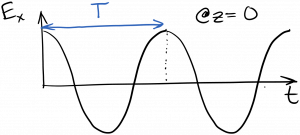We saw that the solutions to the scalar wave equation were of the form
$latex \displaystyle E_x = f(z \pm v_p t) $
where $latex f$ was any twice-differentiable function. I’m going to start using sinusoidal or harmonic functions for $latex f$ – functions like cosine, sine, and complex exponentials. Let’s start with cosine. We should certainly be allowed to replace $latex f$ with a cosine, as it is twice differentiable. If we do so, we have
$latex \displaystyle E_x = A \cos {(k(z – v_p t))} $
I decided to go with the minus sign for the forward-propagating wave (wave traveling in the $latex +z$ direction), and I slipped in a few new constants: $latex A$ out front, which is just the amplitude of the cosine wave; and a $latex k$ inside the cosine, which I’ll discuss below. Neither of these constants changes the fact that this harmonic wave is a solution to the wave equation, because it’s still twice-differentiable, and it still has the necessary $latex (z – v_p t) $ grouping inside. I’m going to rewrite the harmonic wave a bit without really changing it. First I’ll bring the $latex k$ inside the parentheses:
$latex \displaystyle E_x = A \cos {(kz – k v_p t)} $
The quantity in front of $latex t$ in a harmonic function is just the angular frequency $latex \omega$, so we can rewrite this as
$latex \displaystyle E_x = A \cos {(kz – \omega t)} $
where we must have
$latex \displaystyle \omega = k v_p$
You probably have some intuitive feel for the angular frequency $latex \omega = 2 \pi \nu$, where $latex nu$ is the ordinary frequency, often given in Hertz ($latex Hz$). For example, as $latex \omega$ gets bigger, the harmonic function is oscillating faster in time. The period of oscillation – the time it takes for the oscillation to undergo one complete cycle – is just
$latex \displaystyle T = \frac{1}{\nu} = \frac{2 \pi}{\omega}$

Slightly newer is $latex k$, which is called the wavenumber. Looking at our harmonic wave, notice that $latex k$ sits in front of $latex z$, just as $latex \omega$ sits in front of $latex t$. In fact, the wavenumber $latex k$ plays the same role as $latex \omega$ does, except that it applies to the wave’s oscillation in space, rather than time. So, as $latex k$ gets bigger, the harmonic wave is oscillating faster in space. We can think of the wavenumber $latex k$ as being an angular spatial frequency.
The wavelength $latex \lambda$ is the spatial distance between peaks of the wave; i.e. it’s the distance over which the oscillation undergoes one complete cycle. It’s analogous to the period, but applied to space, rather than time. Similar to how the period $latex T = 2 \pi / \omega$, the wavelength
$latex \displaystyle \lambda = 2 \pi / k$.

We can do a little manipulation here to come up with a very famous equation. We already know that
$latex \displaystyle \omega = k v_p$
and we know $latex \omega = 2 \pi \nu$, and $latex k = 2 \pi / \lambda$. In the next section we will see that the phase velocity $latex v_p = c / n$. Putting all of this together and rearranging things,
$latex \displaystyle \lambda \nu = \frac{c}{n}$
In words, wavelength times frequency equals the speed of light divided by the refractive index. This holds for all electromagnetic waves, including light.
Below are some animations to illustrate the connections between $latex \lambda$, $latex v_p$, and $latex \omega$.
Animation showing a wave with amplitude A = 1, $latex \lambda = 1$, and $latex v_p = 1$:
Animation showing a wave with amplitude A = 2, $latex \lambda = 1$, and $latex v_p = 1$:
Animation showing a wave with amplitude A = 1, $latex \lambda = 0.5$, and $latex v_p = 1$:
(Notice how the frequency $latex \omega$ has increased, because the faster spatial oscillations translate into faster time oscillations when the wave passes at a fixed speed.)
Animation showing a wave with amplitude A = 1, $latex \lambda = 1$, and $latex v_p = 2$:
(Notice how the frequency $latex \omega$ has increased, even though the spatial frequency $latex k$ have not, because the spatial oscillations are passing by faster.)


You must be logged in to post a comment.